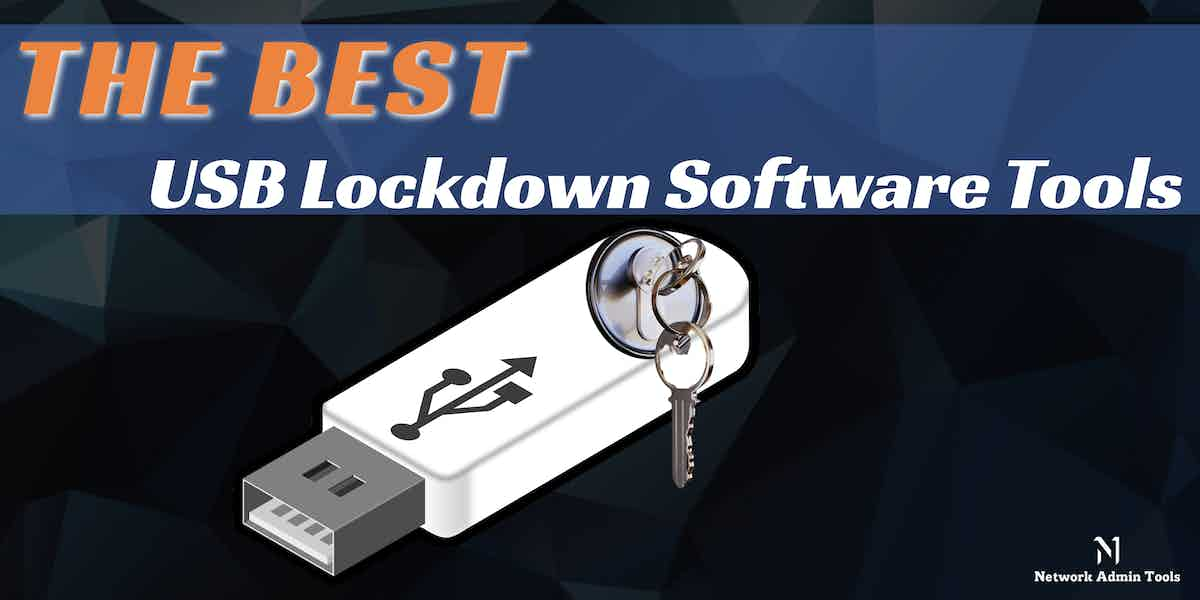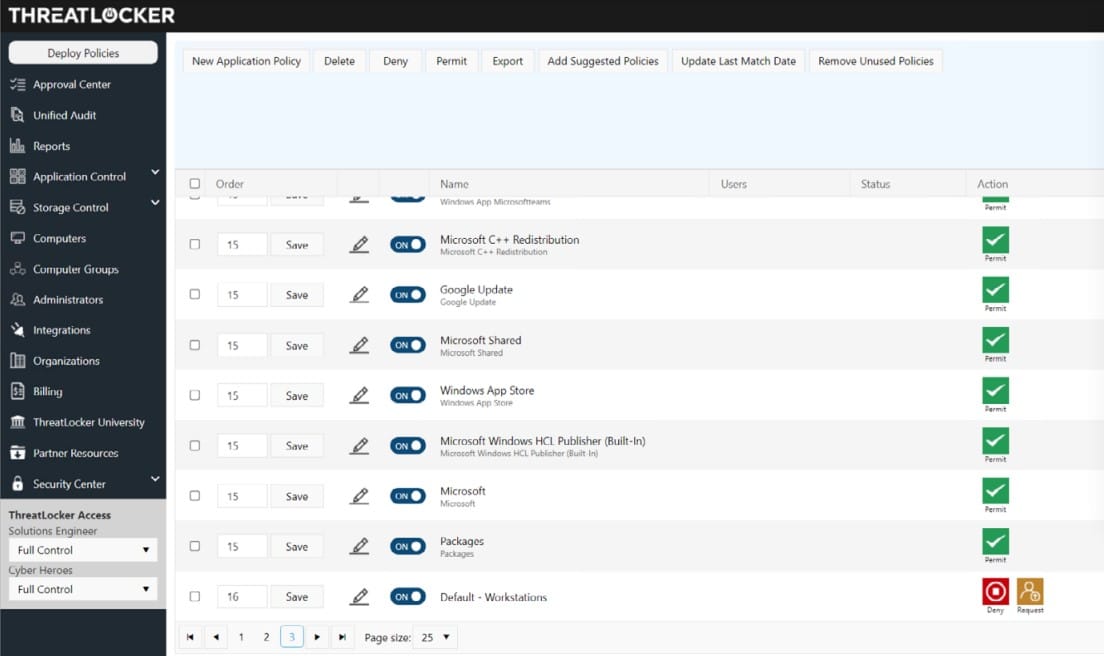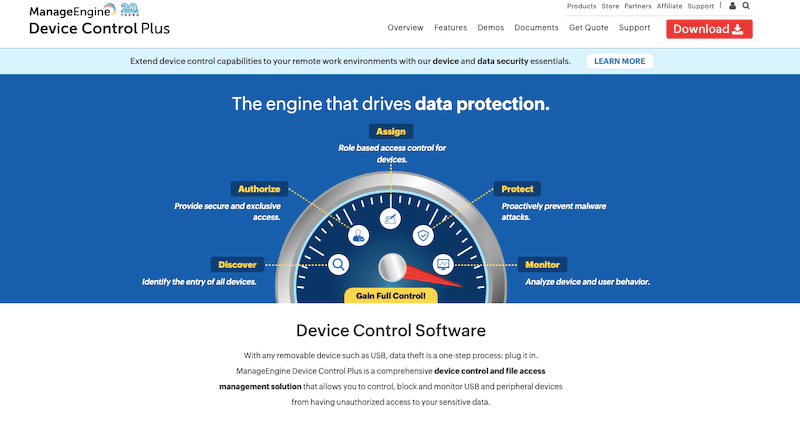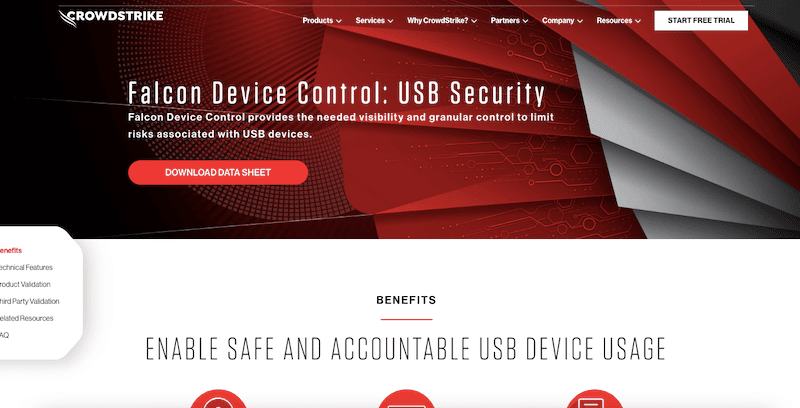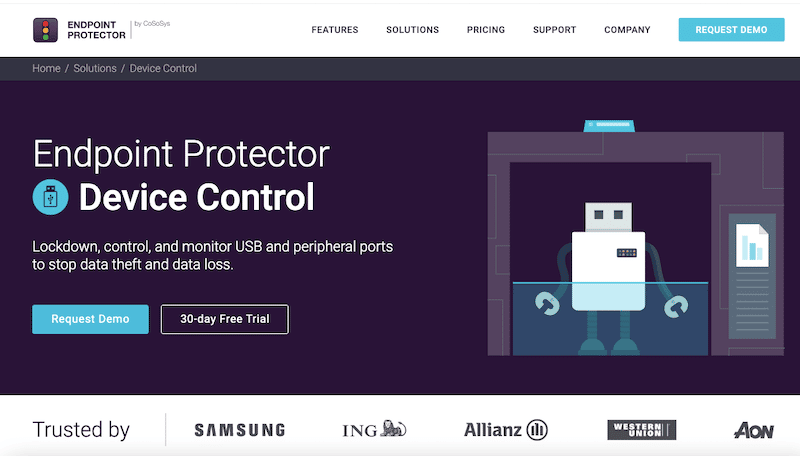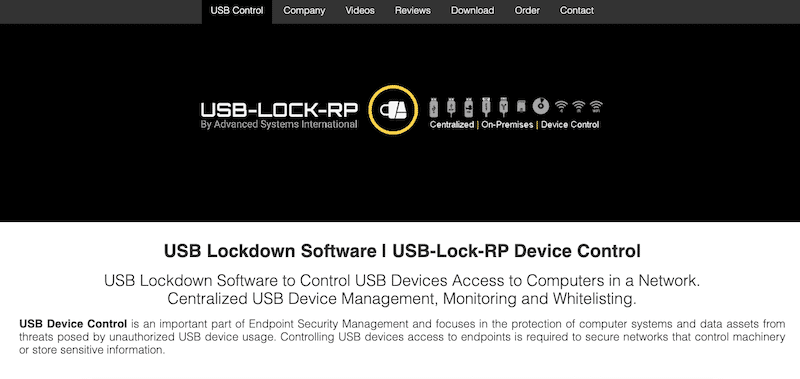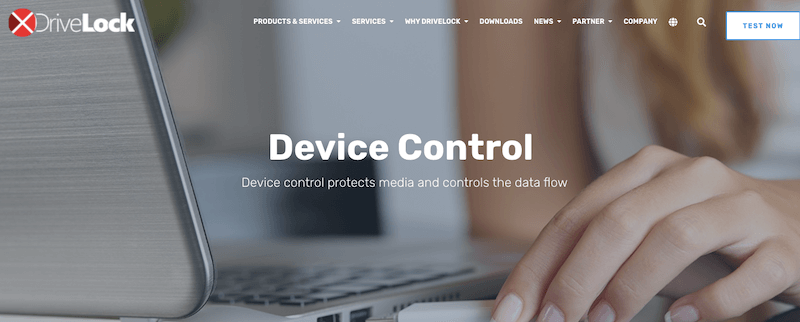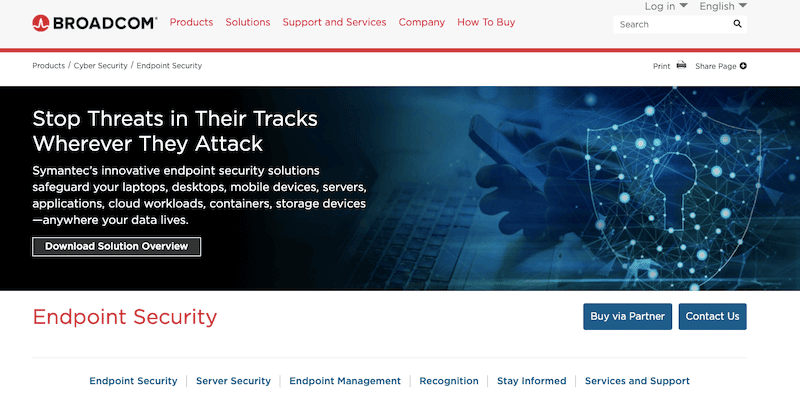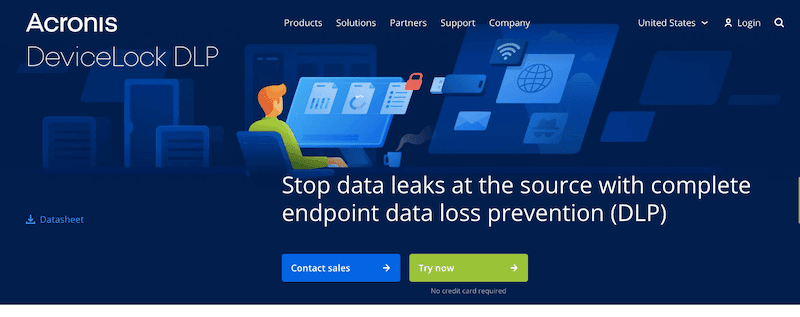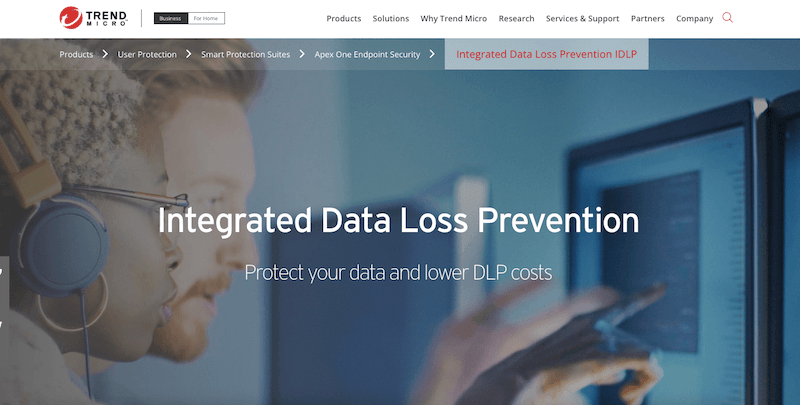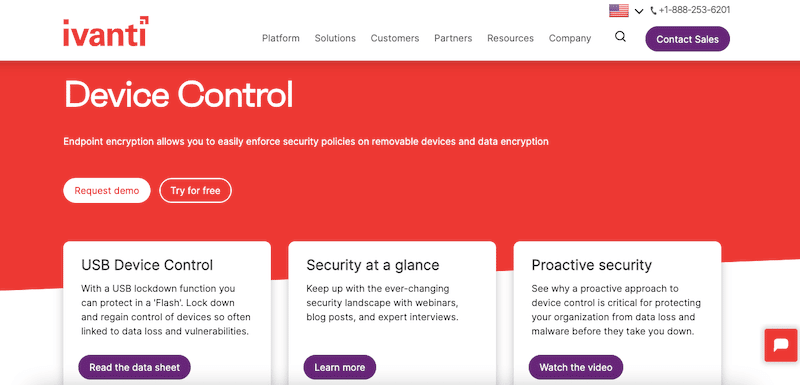Locking down USB ports is one of the best security practices to ensure organizations are safe from data loss, data theft, or malware infection.
In this post, we will go through the ten best USB lockdown software tools that will help you protect your organization from data theft, data leaks, or Malware.
USB pen drives are the most accessible removable media for anyone wanting to steal data or inject Malware. An insider can steal sensitive company data stored in servers or workstations with unsecured I/O ports by simply plugging in a USB drive. In addition, an outsider (such as a hacker) could use social engineering techniques like USB baiting or USB scams to inject Malware into the network.
Here is our list of the best USB lockdown software tools:
- ThreatLocker Storage Control – EDITOR’S CHOICE This tool blocks all USB devices from attaching to computers on a network. These blocks can be lifted by a central administrator for access by an authorized user. Access a free demo.
- ManageEngine Device Control Plus – FREE TRIAL An endpoint security solution with a focus on DLP. It lets you monitor, control, and block USBs. Start a 30-day free trial.
- CrowdStrike Falcon Device Control A USB lockdown software that gives you full visibility and granular control for safe USB utilization.
- Endpoint Protector by CoSoSys A DLP solution that can centrally monitor, control, and block USB ports (and other peripherals).
- USB-Lock-RP An enterprise-grade device control software, capable of monitoring, controlling, and locking down USB ports.
- DriveLock Device Control A cloud-based endpoint protection platform, with a focus on zero-trust security, and fantastic USB lockdown capabilities.
- Symantec Endpoint Protection More than a simple USB lockdown tool, Symantec Endpoint Protection emphasizes data protection.
- Acronis DeviceLock DLP An endpoint DLP solution that offers device control and endpoint management.
- McAfee DLP Endpoint (now Trellix DLP) An all-in-one DLP solution that integrates Endpoint Protection capabilities, including USB blocking (and much more).
- Trend Micro IDLP A solution that lets you implement device protection controls and policies, to prevent data loss from USB devices, and other media.
- Ivanti Device Control A solution for enforcing data encryption and security policies on USBs or other removable media.
What to consider when looking for a USB lockdown software tool?
A USB lockdown software tool is usually a component or utility from a Device Control or Data Loss Prevention (DLP) solution. These USB lockdown tools are rarely dedicated software specially designed for locking down USBs.
Most enterprise endpoint protection or antivirus solutions with centralized management usually come with device control capabilities or DLP, which let you block USB devices. These solutions will also allow you to create device allowlists/blocklists, OTPs (One-Time-Passwords), enforce encryption, transfer limits, etc. These tools can even extend to the point that they allow you to block USB drives by vendor, type, product ID, etc. These solutions install on the endpoint (as agents) and are password-protected so that the end-user cannot tweak any settings.
Recommended features when looking for a USB lookdown tool:
- Support and identify different USB peripherals.
- Centralized control to enforce policies and monitor USBs.
- Automated response to policy violations.
- Set policies for USB transfer limits.
- Configure allowlists to allow or block certain USBs.
- Active Directory integration.
- Enforce USB encryption.
Keep in mind that disabling USB storage does not disable USB functionality entirely. USB storage lockdown software prevents the computer from recognizing storage (usbstor values), but the USB port is still alive. This means end-users would still be able to charge their phones or USB-powered devices and use phone apps like tethering to connect to the network. This is why complete endpoint protection with DLP capabilities and Antivirus becomes handy.
The Best USB Lockdown Software Tools
1. ThreatLocker Storage Control – GET DEMO
ThreatLocker Storage Control is a USB device management package that is available as part of a package of system security tools. The USB manager blocks all storage devices from attaching to a computer on the network by default. Each device is identifiable by a serial number and the system administrator can choose to allow a specific device to connect.
Key Features
- Enforce security policies
- Integrates with system-wide security
- Central control
- Allow access only to specific users
Why do we recommend it?
ThreatLocker Storage Control offers a robust, centralized solution for USB device management, integrating seamlessly with existing security systems. Its unique feature set allows for highly granular control over USB device permissions, enhancing overall network security.
Who is it recommended for?
This tool is ideally suited for system administrators and security professionals who are responsible for enforcing strict security policies across a network. It is particularly beneficial for organizations that need to regulate access to storage devices on both a user and device-specific basis.
The ThreatLocker system is a combination of disabling the ability of equipment and software and an extended access rights management service that selectively reactivates those assets. While typical ARMs apply permission levels for resources when accessed by a named user account, the threatLocker system splits that resource part in two – so you have combinations of software and resources (files, devices, printers, etc) to which users are granted access.
Pros:
- Covers local drives, network shares, and peripheral devices, such as USB sticks
- Choose to block by default
- Permit USB devices to attach on request
- Identify USB devices by serial number
- Authorize use per user and/or per endpoint
Cons:
- No price list
How to start with ThreatLocker Storage Control? The way to understand the ThreatLocker system is to access the free demo to assess the entire platform, including the Storage Control module.
EDITOR'S CHOICE
ThreatLocker Storage Control is our top pick for USB lockdown software because it applies a security policy for all USB devices across an organization. All USB ports remain active and contactable for further instructions while rejecting all USB devices by default. The system administrator can then selectively approve a device by its ID. Its usage can be limited to one device for a specified user or it can be approved to attach to any computer on the system. There is a mechanism for users to seek approval for a device.
Download: Get FREE Demo
Official Site: https://portal.threatlocker.com/signup.aspx
OS: Cloud-based
2. ManageEngine Device Control Plus – FREE TRIAL
The ManageEngine Device Control Plus is an endpoint security solution with a strong focus on Data Loss Prevention. The software lets you monitor in real time and remotely control (block or allow) removable devices such as USB devices, drives, and other peripherals.
Key Features
- Granular reports and audits.
- Identify devices with excessive privileges.
- Receive instant alerts if unauthorized access.
- Zero-trust approach to control devices.
Why do we recommend it?
ManageEngine Device Control Plus excels in real-time monitoring and controlling of removable devices, providing a strong layer of Data Loss Prevention. Its role-based access and automatic updates offer a comprehensive and up-to-date security solution.
Who is it recommended for?
This tool is highly recommended for organizations that need robust endpoint security and are concerned about data loss or unauthorized access to sensitive information. It is particularly well-suited for businesses that require role-based access controls and real-time monitoring capabilities.
Pros:
- Only administrators can access password-protected backup copies
- Enables users to detect any malicious insider behavior right away
- Provides automatic updates and protection against viruses in real-time
- All vents and external devices that are plugged in can be controlled and monitored for file actions
- The role-based access feature prevents other sources from copying sensitive material without the administrator’s consent
Cons:
- Blocks portable exe files
- The configuration and App distribution process is time-consuming
The ManageEngine Device Control Plus comes with a web-based administrative UI console that helps you block and monitor all USB devices easily from a single place. The software provides granular control by allowing you to assign access and data transferring policies and respectively push them to clients. You can also get device and information activity reports from clients.
How to start with ManageEngine Device Control? Register to get a fully functional 30-day free trial.
3. CrowdStrike Falcon Device Control
CrowdStrike is a leading cloud-native cybersecurity platform built to provide complete protection. The software allows users to use one platform with a single agent to deliver endpoint security, cloud security, threat intelligence, identity protection, and security & IT operations. CrowdStrike’s Falcon Device Control is one of the best USB lockdown software tools that gives you the proper visibility and granular control for safe USB usage.
Key Features
- Get insights and granular control.
- Set policies and monitor USB usage.
- Pre-built dashboards.
- Searchable history and logs of USB utilization.
Why do we recommend it?
CrowdStrike Falcon Device Control stands out for its comprehensive, cloud-native approach to device security. It offers fast local controls and a pre-built dashboard that allows for real-time tracking, identification, and blocking of threats.
Who is it recommended for?
This platform is recommended for IT professionals and security teams in organizations that require an all-in-one solution for cybersecurity, particularly in environments that are rapidly evolving or scaling. Its cloud-native architecture also makes it well-suited for businesses that are primarily cloud-based.
Pros:
- Offers fast local controls and unravels the entire attack
- Runs proper research, provides streamlined notifications and performs analysis of investigation query results in seconds
- The continuous monitoring features keep the user informed of everything that is happening and help in identifying risks more quickly
- The pre-built dashboard allows users to track, identify and block threats in real-time
- There is no need to install additional endpoint software or hardware in order to use the software
Cons:
- Adapting the look and feel of the platform is challenging for some users
- Do not provide restrictions over different data exfiltration channels
Falcon Device Control uses an agent that can be installed in Windows and macOS systems. Once installed, the software can automatically discover agents within the same network. This agent collects data from the monitored USB device and reports back to the server. Users can also push commands to the agent from the server to limit USB usage.
How to start with Falcon Device Control? Contact CrowdStrike customer service for more information. You can also begin with CrowdStrike software by trying Falcon Prevent (a powerful AV) for a 15-day free trial.
4. Endpoint Protector by CoSoSys
Endpoint Protector by CoSoSys is a cross-platform Data Loss Prevention (DLP) solution. It prevents data leaks and theft and provides granular control for USBs and other portable storage devices. The software can be deployed via virtual appliance, over the popular cloud services, or SaaS.
Key Features
- Define granular policies for users, computers, or groups.
- Identify unique USBs, monitor them, and stop them.
- Force USB data encryption.
- Grant or revoke USB access remotely.
- Create device’s allow lists and blocklists.
Why do we recommend it?
Endpoint Protector by CoSoSys provides a robust and comprehensive solution for managing data loss through USBs and other removable storage devices. Its built-in reporting and granular control policies make it a stand-out choice for securing corporate networks.
Who is it recommended for?
This software is ideal for businesses of all sizes that are focused on preventing data loss and enhancing internal data security measures. It is particularly useful for companies that operate in multiple languages and across different platforms like Windows, macOS, and Linux.
Pros:
- Provides a comprehensive solution for securing corporate networks from the threat of removable storage devices
- Runs regular scans to prevent data breaches
- The user interface supports 10+ languages
- The built-in reporting and analysis feature aid in keeping track of all actions connected to the operation of the device or file transfers
- Helps businesses improve their data security policy by enabling the use of the Cut, Copy, and Paste tool to eliminate data leaks of sensitive information
Cons:
- Source code detection requires improvement
- CoSoSys does not offer protection for applications developed by third parties
Endpoint Protector’s Device Control is one of our favorite USB lockdown software tools. It can centrally block, control, and monitor USB (and other peripheral) ports to avoid data loss, theft, or potential USB-borne Malware. The software monitors (remotely) USB ports using a lightweight agent installed on Windows, macOS, or Linux. The agents enforce the policies on the client and are password-protected.
How to start with the CoSoSys endpoint protector? Request a demo.
5. USB-Lock-RP
USB-Lock-RP by Advanced International Systems is an enterprise-grade device control software capable of controlling and locking down USB ports. The USB-Lock-RP software provides a centralized platform for managing and monitoring USB devices, including other removable storage, mobile devices, wireless adapters, and groups of computers.
Key Features
- Allow listing: Allow specific USB devices and block the rest.
- Lock down USB ports as soon as the software detects unauthorized USB.
- Enforce encryption when transferring data from PC to authorized USBs.
- Enforce group policy settings in real time.
- Set Read-Only mode policy to specific USB devices.
Why do we recommend it?
USB-Lock-RP offers enterprise-grade control over USB ports and other removable storage, providing real-time policy enforcement and data encryption features. Its advanced capabilities make it a strong choice for organizations needing comprehensive USB security.
Who is it recommended for?
This tool is best suited for enterprise environments where centralized management of USB and other removable devices is crucial. It’s particularly beneficial for organizations that rely heavily on Windows machines and need real-time monitoring and enforcement of security policies.
Pros:
- The advanced features control and lock USB ports to detect unauthorized USBs
- Only specific USB devices are supported, rest the tool block for security purposes
- Encrypts data when transferring files from the system to authorized USBs
- Real-time enforcement of group policy settings
- USB-Lock-RP is highly compatible with remote desktops
Cons:
- To use authorized devices, the user must re-plug the device
- Does not operate on Linux or MAC
USB-Lock-RP’s centralized management console runs on-premises on Windows machines. The sys admin can configure access policies to control devices and enforce new rules on individual computers or entire groups of computers. In addition, the software also shows alerts and logs, including USB file transfer monitoring.
How to start with USB-Lock-RP? Download the USB-Lock-RP free demo and manage device access for up to five clients. The license price is $20.00 USD per client (for 10-100 clients) and $15.00 USD per client (for 110-500 clients).
6. DriveLock Device Control
DriveLock is a fully integrated cloud-based endpoint protection platform designed to safeguard a company’s data, devices, and systems. The software uses a zero-trust approach (never trust, always verify) and its team of security experts to achieve a high degree of security. DriveLock’s solutions are certified with the Common Criteria EAL3+ certificate, a global security standard.
Key Features
- Monitor USB device’s data transfers.
- Automatically encrypt USB drives and other external media.
- Access forensics analysis and extensive reports.
- Use Machine Learning to configure integrated devices.
Why do we recommend it?
DriveLock Device Control provides a robust multi-layered endpoint security solution with features like automatic USB encryption and data transfer monitoring. The software’s certification with the Common Criteria EAL3+ further establishes its credibility in offering high-level security.
Who is it recommended for?
DriveLock is ideal for organizations seeking a comprehensive and certified endpoint security solution. It’s particularly useful for businesses that use a zero-trust security approach and require both on-premise and cloud deployment options.
Pros:
- Enables users to keep track of every single file copied from one location to the other
- DriveLock encrypts external USB data carriers automatically and runs extensive forensic analysis
- Enables the management and configuration of security profiles during cloud hosting
- Requires no additional third-party software with DriveLock
- The multi-layered endpoint security enables users to keep track of all connected internal and external devices
Cons:
- Not the best choice for non-technical viewers
- Lacks few advanced features compared to other tools
DriveLock’s Device Control is a fantastic USB lockdown software tool. It allows organizations to protect themselves from unauthorized or unencrypted USB devices and data transfers. With DriveLock, you can also create allowlists to permit specific devices and deny others. You can deploy DriveLock on-premise or via their cloud solution.
How to start with DriveLock Device Control? Register to download a 30-day free trial.
7. Symantec Endpoint Protection
Symantec Endpoint Protection by Broadcom is an excellent choice if you are looking for more capabilities than simply locking down USBs. This solution might seem feature overkill for people only looking to lock down USB ports. The software also includes capabilities for intrusion prevention, firewall, anti-malware, and the foundational features of DLP software. It deploys in on-premise, cloud, or hybrid environments.
Key Features
- Block data transfers from/to unauthorized USB flash drives.
- A single agent for Endpoint Protection and other Symantec products.
- A single console to deploy, manage, and monitor endpoints.
- It integrates with Symantec EDR, breach prevention, and app control.
Why do we recommend it?
Symantec Endpoint Protection offers a comprehensive security suite that goes beyond just USB lockdown. Its machine learning and AI capabilities offer low false positives, making it a reliable choice for multiple layers of endpoint security.
Who is it recommended for?
This software is best suited for medium to large enterprises looking for an all-in-one security solution that includes not only USB port lockdown but also intrusion prevention, firewall, and anti-malware features. Organizations that require flexible deployment options, like on-premise, cloud, or hybrid, will also find Symantec Endpoint Protection particularly beneficial.
Pros:
- Runs regular scans for detecting security threats
- For tracking network traffic, it blocks unapproved apps and employs strict firewall regulations
- With a central control panel and an online gateway, Symantec Endpoint Security may be operated on-premises or in the cloud
- Uses cutting-edge AI and machine learning to guarantee a low probability of false positive detection
- Using an administrative console, IT administrators may create and modify security policies
Cons:
- The security module requires attention and improvement
- When we enable the IPS/IDS capability, there are occasionally issues with performance on the end devices
Symantec Endpoint Protection (SEP) emphasizes data. It protects data wherever it lives; at endpoints, desktops, cloud workloads, mobiles, servers, apps, containers, and storage devices. SEP includes an application and device control policy that lets you block all USB drives, from pen drives to hard drives on the clients. The software can also identify hardware IDs to help create allowlists and permit or stop specific USB drives or peripherals.
How to start with Symantec Endpoint Protection? Contact sales to request a demo or trial.
8. Acronis DeviceLock DLP
Acronis DeviceLock DLP is an endpoint data loss prevention (DLP) solution designed to lower the risk of insider data leaks, threats, or data theft. Acronis Device DLP offers device control and endpoint management under the Data Loss Prevention umbrella solution.
Key Features
- Event logging, data shadowing, reporting, and alerting.
- Fine-grained contextual control based on multiple factors.
- Allow listing: Allow specific USB devices or provide temporary access.
- Extract and inspect textual data with Optical Character Recognition (OCR).
Why do we recommend it?
Acronis DeviceLock DLP stands out for its robust endpoint data loss prevention capabilities and fine-grained control. Its ability to examine the content and context of data transfers, along with OCR capabilities, makes it an excellent tool for securing sensitive data.
Who is it recommended for?
This tool is particularly useful for organizations concerned about insider threats and data leaks. It’s well-suited for businesses that require precise control over data transfers, as well as those needing to comply with strict data protection regulations.
Pros:
- Ability to stop data leaks from endpoints without the need for lengthy deployment processes
- Examines the content and context of data transfers and imposes policy-based preventive controls, to stop data leakage via peripheral devices
- Allows giving temporary access or listing specific USB devices
- Uses OCR to extract or inspect textual information
- Provides centralized management console to set and enforce strict policies
Cons:
- After installing, you may find finds issues with various devices
- Does not open HTTPS sites in Yandex Browser
Acronis DeviceLock uses a simple and lightweight agent deployed on the client. It also offers Active Directory integration and a centralized management console from which you can set and enforce policies. Device Lock is one of the best USB lockdown software because of its flexibility. It can work via local data channels (USB, FireWire, SMBs, etc.) that can be allowed, blocked, alerted, or logged.
How to start with Acronis DeviceLock DLP? Register to download a 30-day free trial.
9. McAfee DLP Endpoint (Now Trellix DLP)
McAfee Data Loss Prevention, now Trellix DLP, is an all-in-one DLP solution including McAfee DLP Discover, McAfee DLP Prevent, McAfee DLP Monitor, McAfee DLP Endpoint, McAfee Device Control, and MVISION Cloud Integration. The McAfee DLP Endpoint can provide USB lockdown capabilities and so much more. It covers all data leaking channels, including USBs, removable media, email, IM, web, cloud, printing, screen captures, clipboard, file-sharing applications, etc.
Key Features
- Create reports using more than 20 customizable reports.
- Ensure compliance with automated audits and reports.
- Manage and deploy policies from a central platform.
- Block all USB devices and set exclusions.
- Only allow access to USB-encrypted devices.
Why do we recommend it?
McAfee DLP Endpoint excels in providing comprehensive coverage against data leaks across various channels, not just USBs. The tool’s real-time alerts and robust policy management make it a solid choice for a holistic data loss prevention strategy.
Who is it recommended for?
Trellix DLP is ideal for organizations that need an all-encompassing approach to data loss prevention across multiple platforms. It is particularly useful for businesses that have complex needs, including compliance with stringent data protection laws and regulations.
Pros:
- Protects your private information against theft or loss
- Provide real-time alerts and reports on current events and activities
- Controls data transmission to portable storage devices, even if they are not connected to the network
- Uses the ‘Lock Down Devices’ feature to protect and block removable storage devices
- Filters and blocks sensitive data on any portable storage device based on content
Cons:
- Updating policies on DLP clients is a challenging task
- There is no discovery mode, OCR, or AI-based technique in McAfee DLP Endpoint
The solution works on-premise but can also be extended to the cloud with its integration to MVISION Cloud. This approach ensures that sys admins can also extend the on-premise DLP policies to the cloud. The native integration to MVISION ePO helps simplify policy and incident management.
How to start with McAfee DLP? Request a Free Demo.
10. Trend Micro IDLP
Trend Micro Integrated Data Loss Prevention (IDLP) (for Business) is a solution that combines with other Trend Micro solutions (such as Apex One Endpoint Security) and management consoles. IDLP lets you implement device protection controls and policies and improve visibility. With IDLP, you can prevent data loss from USB devices or other media such as email, SaaS apps, web, or cloud storage.
Key Features
- Automate response to policy violations.
- Granular device control and DLP policies.
- Out-of-the-box compliance templates.
- Forensic data captures and real-time reports.
Why do we recommend it?
Trend Micro IDLP stands out for its integrated approach, offering granular device control and data loss prevention policies across a variety of media. The tool’s out-of-the-box compliance templates and advanced techniques for preventing data loss make it a powerful choice.
Who is it recommended for?
This solution is particularly suitable for businesses that need a comprehensive and integrated approach to data loss prevention across multiple channels such as USB devices, emails, and cloud storage. It is also ideal for organizations looking to meet various compliance requirements, thanks to its pre-configured templates.
Pros:
- Offers better visibility, granular device control, and quick deployments
- Comprises expanded investigative capabilities and uses advanced techniques to prevent data loss
- Using its single EDR toolkit, solid SIEM connectivity, and an open API set, you may gain actionable insights
- Offers improved detection of advanced malware, including ransomware
- The innovative behavior analysis provides efficient defense against scripts, injection, ransomware, and other threats
Cons:
- Requires a better logging feature
- It is buggy and requires improvement
Trend Micro IDLP uses a lightweight agent installed on clients, which gives you visibility and control over your USB ports. You can restrict specific USB devices while allowing others. When the software detects a violation, you can configure it to automatically respond with actions like logging, blocking, encrypting, alerting, bypassing, modifying, quarantining, or deleting data.
How to start with Trend Micro IDLP? Register to start an Apex One Endpoint Security free SaaS trial that integrates with IDLP.
11. Ivanti Device Control
Ivanti Device Control is a solution that allows you to enforce data encryption and security policies on USBs and other removable media. Ivanti Device Control is one of the best USB lockdown software because it will enable you to quickly lock down and re-take control of devices (such as USBs) highly associated with data loss and malware infection.
Key Features
- Protect endpoints from rogue USB drives.
- Centrally manage devices with an allowlist (default-deny) approach.
- Grant users temporary or scheduled access to USBs.
- Apply policies to all USBs by class, group, model, or specific ID.
Why do we recommend it?
Ivanti Device Control excels in offering a robust, centralized platform for managing a wide range of endpoints, from USB drives to Bluetooth beacons. Its “default deny” approach, integrated with Windows Active Directory, allows for highly customized and secure device management.
Who is it recommended for?
This software is ideal for enterprises that have a complex network of devices and require centralized control. It is especially useful for organizations that adopt a zero-trust security model, as it integrates seamlessly with Windows Active Directory to offer granular permissions based on user roles.
Pros:
- With access to endpoints, such as Bluetooth beacons, USB sticks, and printers, you can better monitor and manage your devices
- Allows users to use a whitelist/”default deny” Technique to centrally manage devices and their crucial files
- Even users with administrator ability cannot remove Ivanti Device Control agents without authorization
- Depending on their Windows Active Directory, administrators can grant users or user groups permissions
- Allows you to remain proactive and responsive to incoming security threats by increasing transparency across silos
Cons:
- The console’s design is a little complicated
- Reports’ email functions could be improved
Ivanti discovers every endpoint where a client has been deployed. These discovered devices can be managed and controlled from a single console. The system uses a zero-trust approach, so you’ll be able to set allowlists, where you define which devices are allowed (while the rest are blocked). You can then enforce the security policies for the specific USB devices (determined by type or ID).
How to start with Ivanti Device Control? Request a free demo.
USB Lockdown Software FAQs
Can you lockdown USBs without DLP or device control software?
If you are using Windows, you can disable USBs within an Active Directory domain simply by using Group Policy Objects (GPO). Within an AD, you can use Group Policies to enforce USB restrictions. The simplest way to lock down USB ports in a domain is to configure a GPO to disable ubstor.sys.
How to manually lock down USB ports?
Another simple (but more extreme) suggested solution is to disable USB ports via BIOS. Some computers allow changing these values for removable media (USB storage) but not for main peripherals like mouse and keyboard. Always ensure that USB-based peripherals like mouse, printer, or keyboard are not affected.
How to lockdown USBs if the computer is outside a domain?
If the computer (or set of computers) is outside a domain and you are unable to apply Group Policies, then you could change local registry settings (usbstor values) manually, change BIOS or use hardware-based solutions, such as USB port blockers (find them on Amazon).
Alternatives to USB lockdown software tools?
The first and most simple way would be to train employees not to use USB ports and instead stick to the storage/transferring mechanisms given by the company or charge their phones using wall sockets. You can also use hardware-based USB port blockers.
Can a USB lockdown software protect you from Malware coming from USB baiting?
No, not every USB lockdown solution can save you from avoiding complex USB-infected devices such as those found in the parking lots. Some of these USB scams install drivers (just like a mouse or keyboard) would and are not necessarily storage-based. To protect from such threats, the software can be strengthened with antivirus or endpoint protection.

